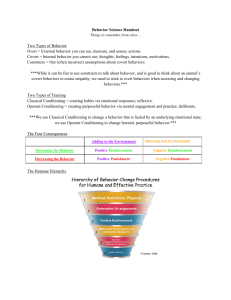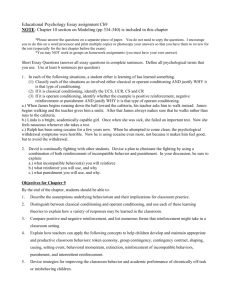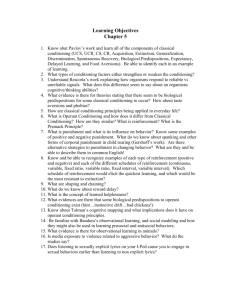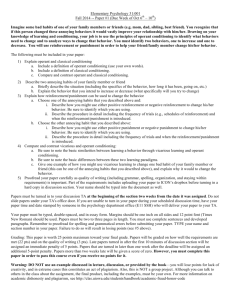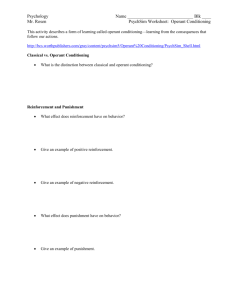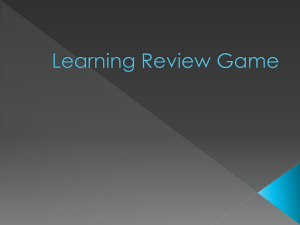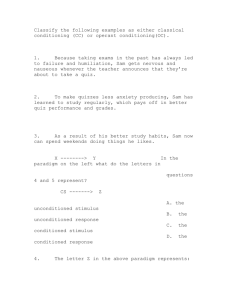Behavioral Psychology
advertisement
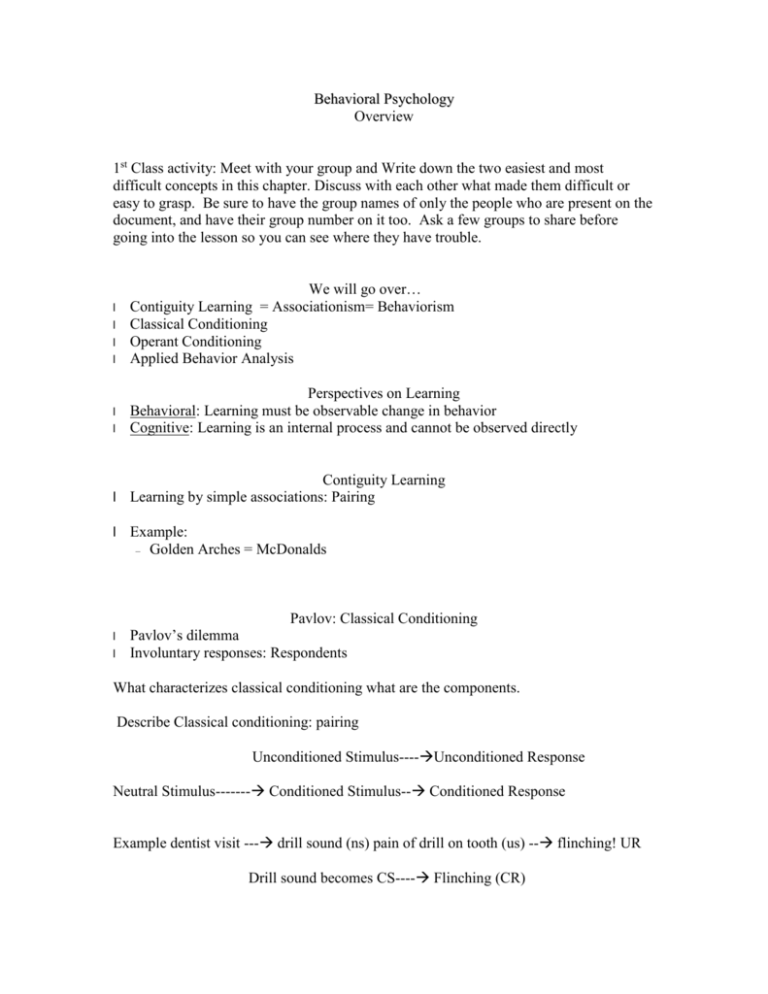
Behavioral Psychology Overview 1st Class activity: Meet with your group and Write down the two easiest and most difficult concepts in this chapter. Discuss with each other what made them difficult or easy to grasp. Be sure to have the group names of only the people who are present on the document, and have their group number on it too. Ask a few groups to share before going into the lesson so you can see where they have trouble. l l l l l l We will go over… Contiguity Learning = Associationism= Behaviorism Classical Conditioning Operant Conditioning Applied Behavior Analysis Perspectives on Learning Behavioral: Learning must be observable change in behavior Cognitive: Learning is an internal process and cannot be observed directly Contiguity Learning l Learning by simple associations: Pairing l l l Example: – Golden Arches = McDonalds Pavlov: Classical Conditioning Pavlov’s dilemma Involuntary responses: Respondents What characterizes classical conditioning what are the components. Describe Classical conditioning: pairing Unconditioned Stimulus----Unconditioned Response Neutral Stimulus------- Conditioned Stimulus-- Conditioned Response Example dentist visit --- drill sound (ns) pain of drill on tooth (us) -- flinching! UR Drill sound becomes CS---- Flinching (CR) Others You could use: Feeding a cat with an electric can opener Events should be .5 seconds or less apart l what parts of the model are involved in extinction? Generalization Discrimination What about situations that we have control over? l l l l l l l l l Skinner: Operant Conditioning Operants: deliberate actions Thorndike’s Law of Effect ABC’s Antecedent-----Behavior------ Consequence Consequences Reinforcement Punishment Shaping Types of Consequences Remember!! Reinforcement always increases behavior, Punishment always decreases it. l l l Positive reinforcement: What can you do to provide this? Examples: – praise – teacher attention – rewards Negative reinforcement: What can you do to create this? – avoid the loss of privileges – take away an aversive stimulus Types of Punishment l l Presentation Punishment – Detention – Extra work Removal Punishment – Loss of recess – Loss of privileges Reinforcement Schedules Use over head transparencies to show the types of schedules there are and then what types of responses to them we can expect. Controlling Antecedents l l l l l l Providing previous information about expected behaviors Cueing when a behavior should be emitted Prompting: Verbal reminder after students do not get quiet after receiving the cue. Applied Behavior Analysis Baseline behavior Target behavior Classroom application: 1 - Specify the desired behavior 2 - Plan a specific intervention 3 - Keep track of the results Have them get into groups to do some work making up their own situations for classical and operant conditioning. Each group should Produce one story for each. Give them about 10 minutes to come up with them. Then Have them share their stories and see if others can see if it matches the model. Be sure to have folks hand them in to you. You can leave them in my office on the table For the Film: Start by saying that we all think we know why students misbehave but let’s think about how this happens. In your groups I want you to come up with the top five reasons that kids get into trouble and misbehave or disrupt class. -What makes this misbehavior happen? try to explain why you think these things happen. Show film after some short discussion of their ideas from there group work. You don’t have to correct them the film will do that for you. After the film get reactions to it what surprised them? What did they expect? Ask them to prepare five things their group thinks they can do to prevent this misbehavior and show the film then you can wrap up with a discussion at the end of how much they agree with the speaker and remember you don’t have to defend him just see if you can clarify his points to the students where you are comfortable. Take the two in class assignments with the videotape and leave them on the counter in my office and you are done! Thanks very much.! Call me on my cell if you need anything. 305-7612200. Figure #1 Number of Disruptive Behaviors for 2week intervention and withdrawal of intervention EN T2 TR EA TM W IT H D R A W A L EN T1 TR EA TM B A SE LI N E 40 35 30 25 20 15 10 5 0 Interventions: Encouraging Positive Behavior l l l l l l l l l l l l Teacher attention Praise & ignore Premack principle Shaping Positive practice Coping with Undesirable Behaviors Negative reinforcement: ‘No recess until…’ Satiation: ‘I would like 1000 of those perfect spit wads, please!’ Reprimands: soft & private Response cost Social isolation Punishment Coping with Undesirable Behaviors Cautions: Use a two pronged approach: – Reinforcement – Punishment Wrap up-



